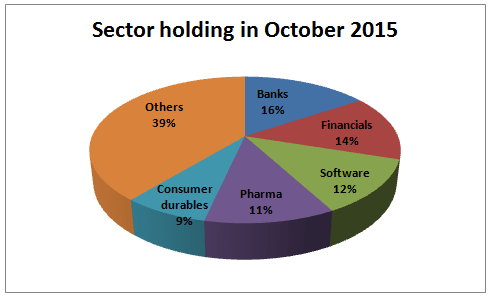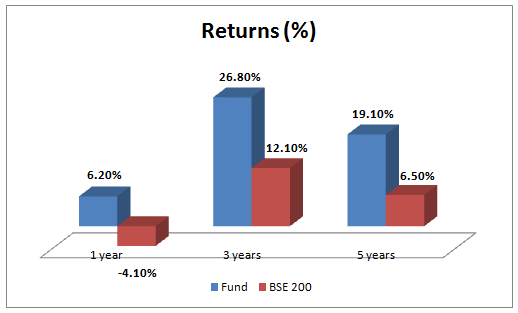It has unfailingly been among the top few performers across time-frames. It is consistent, and it gives you tax breaks under Section 80C of the Income Tax Act. Axis Long Term Equity’s 19.1 per cent five-year return is leaps ahead of the 6.5 per cent put up by its BSE 200 benchmark. Because it is a tax-saving fund, investments (including each Systematic Investment Plan – SIP) are locked in for three years.
Investors with a higher risk appetite can invest in this fund. The higher risk required is owed to the fund’s recent fondness for mid-cap stocks (those with a market capitalisation of less than Rs. 12,000 crore, and over Rs. 2,500 crore). The blistering mid-cap rally from end-2013 onward prompted the fund to make merry. Mid-cap and small-cap holdings have been pruned to 22 per cent now from the 25-30 per cent it had been over 2014-2015.
A higher risk appetite for Axis Long Term Equity is also warranted by its higher volatility, with its standard deviation of returns much higher than its category average.
Winning picks
Axis Long Term Equity does not have a high portfolio churn, tending to take longer term views on stocks. It also appears to pare stake or cash in when valuations or prices rise exponentially. Paring back stake in consumer durables towards the end of 2014, auto and ancillary stocks now are some examples. Stock choices are generally sound companies with good growth potential. Picks that worked out very well include Symphony, TTK Prestige, Kotak Mahindra Bank, Wabco, Sun Pharmaceuticals, and Nestle India, among several others.
Axis Long Term Equity has been proficient at getting its sector calls right too. Early on in this past year, for example, with the sound names in private sector banks (HDFC Bank, Kotak Mahindra, ICICI Bank, and so on) becoming increasingly expensive even as the sector got further mired in woes, the fund put its faith in other financial companies.

HDFC, Gruh Finance, Bajaj Finance and Sundaram Finance saw holding upped in the portfolio. Banks and finance companies form the bulk of the portfolio currently, adding up to 30 per cent. Other consumer plays that can help medium term performance include textiles, consumer durables, FMCG, and auto.
Holding in pharmaceuticals has been upped a fair bit recently, with the sector now accounting for 11 per cent of the portfolio, against the 9 per cent in January 2015. The other typical defensive bet of software has a similar weight in the portfolio. Axis Long Term Equity also has a fair amount of holding in cyclical stocks such as Larsen & Toubro, and other engineering companies.
Steadily ahead
The fund’s stock and sector choices have kept it ahead of the BSE 200 by a massive 10 to 14 percentage points in the one, three, and five year time-frames. It has also been in the top quartile performers of the tax-saving funds category in these time-frames.

Rolling the fund’s three-year returns daily over the past five years, the margin of excess returns over the benchmark has been in the range of 7-18 percentage points. On this rolling basis too, the fund has beaten the BSE 200 all of the time, pointing to a strong degree of consistency in performance.
While volatility is comparatively higher, Axis Long Term Equity’s risk-adjusted returns compare favourably with its category average. The extra risk taken appears to have paid off thus far.
The fund is managed by Jinesh Gopani and has an AUM of Rs. 6,509 crore.
Returns as of November 30, 2015. FundsIndia’s Research team has, to the best of its ability, taken into account various factors – both quantitative measures and qualitative assessments, in an unbiased manner, while choosing the fund(s) mentioned above. However, they carry unknown risks and uncertainties linked to broad markets, as well as analysts’ expectations about future events. They should not, therefore, be the sole basis of investment decisions. To know how to read our weekly fund reviews, please click here.







” It is less volatile, it is consistent, …” and “A higher risk appetite for Axis Long Term Equity is also warranted by its higher volatility …”. These two statements contradict each other. In my opinion, the second one is more appropriate.
Hi Vijay,
Thanks for pointing out the mistake. You are absolutely right – the fund has higher volatility as measured by its standard deviation. It is a consistent performer, though. I’ve edited the write-up now.
Regards,
Bhavana
” It is less volatile, it is consistent, …” and “A higher risk appetite for Axis Long Term Equity is also warranted by its higher volatility …”. These two statements contradict each other. In my opinion, the second one is more appropriate.
Hi Vijay,
Thanks for pointing out the mistake. You are absolutely right – the fund has higher volatility as measured by its standard deviation. It is a consistent performer, though. I’ve edited the write-up now.
Regards,
Bhavana